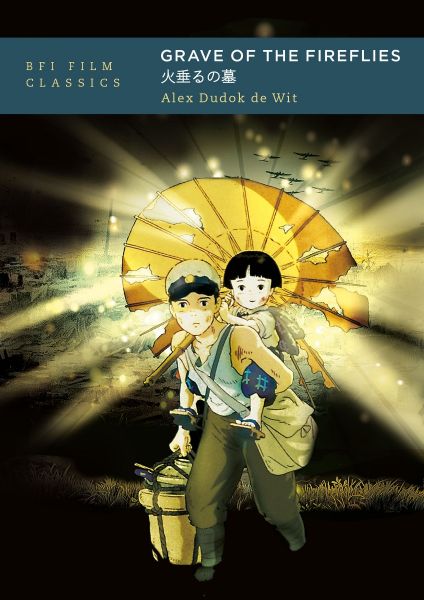In March 1945, as the Pacific War entered its endgame, the United States launched a concerted campaign to destroy Japan’s cities with fire. The stated aim was to cripple the country’s industrial base; in practice, civilians were indiscriminately attacked. Urban Japan, dense with wood and paper, proved highly vulnerable to incendiary bombs. By the war’s end on 15 August, almost all cities of appreciable size lay in ruins.
On 5 June, incendiaries fell on the eastern part of Kobe, the country’s main overseas port. In the ensuing chaos, 14-year-old Akiyuki Nosaka fled his burning home alone. Later that day, at a makeshift hospital, he found his 16-month-old adoptive sister and mother, who was severely burned; his father was never seen again. While their mother recovered, Nosaka and his sister drifted between refuges: first a relative’s home near Kobe, then a bomb shelter, and finally an acquaintance’s house in a different province. Malnutrition stalked them throughout, eventually taking the little girl’s life on 21 August.
Nosaka survived to become one of postwar Japan’s most original writers, but the traumas of these months lived on with him, resurfacing time and again in his work. He revisited this period in his best-known story, the novella Grave of the Fireflies (1967).
Once the US Air Force had disabled Japan’s major metropolises, it set its sights on smaller cities. On 29 June, the campaign reached Okayama, 70 miles west of Kobe. Awoken by the bombs, nine-year-old Isao Takahata found his home empty but for his older sister. Their father had dashed to the school where he was headmaster – protocol required him to protect the ceremonial photograph of the emperor. The rest of the family was in the backyard shelter.
Unaware of this, the pair panicked and fled into the blazing city. When his sister was injured by a blast, Takahata tended to her; she’d later say he had saved her life. They were reunited with their family after two days. Although relatively fortunate, Takahata would rank this experience as the worst of his life. Four decades later, by then a prominent director in Japan’s animation industry, he decided to turn Nosaka’s novella into a feature. He recalled those two days so vividly that details from them ended up in his film.
Takahata’s Grave of the Fireflies (1988), then, is an unusually personal adaptation of a remarkably intimate text. The memories and philosophies of its two authors are entwined, sometimes inextricably, in its simple story. Nosaka was understandably protective of his novella, which he long suspected might be unfilmable. It took Takahata, a man who shared some of his formative experiences, to convince him otherwise. Here was a director with an exceptionally precise artistic vision, working in an environment – Studio Ghibli – geared toward realising that vision, with a medium – animation – that resolved the problems of adaptation.
The story has the shape of a melodrama, and indeed the film is discussed above all in terms of its sadness. Most viewers experience it as a straightforward tragedy – a powerful evocation of war’s worst effects. Its American distributor described it as ‘a three-handkerchief movie on a scale of one to three’, and audience reactions bear this claim out: viewers young and old are often reduced to tears.
When Fireflies came out in Japan in 1988, Ghibli – the animation studio Takahata launched with fellow filmmaker Hayao Miyazaki – was barely established in the country and all but unknown elsewhere. Overseas distribution was peripheral to its business model. But as Ghibli gained immense global renown in the following years, so did Fireflies; in some territories, it was among the studio’s earliest releases and helped create that renown. It has assumed places in the canons of both animation and war cinema – a rare distinction. In 2018, USA Today sought to determine the greatest animated film of all time by aggregating user and critic scores on the websites IMDb and Rotten Tomatoes; Fireflies came top.
Reviews, Japanese and otherwise, tend to focus on the film’s capacity to move us. Relatively few ask what else it may be trying to do. Rarely is it substantially criticised, except when political sensitivities come into play. Commentary on the film can strike an almost reverential tone, as if its solemn subject and roots in autobiography place it beyond reproach. This consensus is a kind of vindication for Takahata, who was warned, when he set out to create a sombre historical drama with a realism almost unprecedented in animation, that nobody would want to watch such a film. Yet it also belies the nuances of his intentions and indicates that, in an important sense, Fireflies was a failure.
Extracted from Grave of the Fireflies by Alex Dudok de Wit (BFI Film Classics, 2021). Reproduced by kind permission of Bloomsbury Publishing. ©Alex Dudok de Wit
GRAVE OF THE FIREFLIES (HOTARU NO HAKA)
Director: Isao Takahata
Production Company: Shinchosha
Executive Producer: Ryoichi Sato
Producer: Toru Hara
Unit Production Managers: Atsushi Kamimura, Kazuyoshi Tanaka
Assistant Director: Norihiko Sudo
Screenplay: Isao Takahata
Based on the novel by: Akiyuki Nosaka
Director of Photography: Nobuo Koyama
Camera Operators: Masashi Abe, Akitaro Daichi, Shinji Ito, Atsushi Kageyama, Tsuguo Ozawa, Naoyuki Taniguchi
Editor: Takeshi Seyama
Special Effects: Kunji Tanifuji
Animation Director: Yoshifumi Kondo
Key Animator: Kitaro Kosaka
Art Director: Nizou Yamamoto
Music: Michio Mamiya
Sound Designer: Yasuo Uragami
Sound Mixer: Hisanori Oshiro
Voice Cast
Ayano Shiraishi (Setsuko)
Tsutomu Tatsumi (Seita)
Yoshiko Shinohara (mother)
Akemi Yamaguchi (aunt)
Japan 1988
89 mins
The screening on Thu 19 May will be introduced by Alex Dudok de Wit, author of BFI Film Classics: Grave of the Fireflies
Grave of the Fireflies by Alex Dudok de Wit is available to buy from the BFI Shop: https://shop.bfi.org.uk/grave-of-the-fireflies-bfi-film-classics-paperback.html

ANIME CLASSICS PART 2
Tekkonkinkreet (Tekkon kinkurîto)
Sun 1 May 12:10; Thu 5 May 20:50
The Tale of The Princess Kaguya (Kaguya-hime no Monogatari)
Tue 3 May 14:00; Tue 3 May 17:30 (all BFI IMAX)
Akira
Tue 3 May 20:30; Mon 23 May 15:00; Mon 23 May 20:30 (all BFI IMAX)
Lupin the 3rd: The Castle of Cagliostro (Kariosutoro no Shiro)
Wed 4 May 14:30; Tue 31 May 20:45
Fullmetal Alchemist the Movie: Conqueror of Shamballa (Gekijô-ban Hagane no Renkinjutsushi: Shanbara o Yuku Mono)
Fri 6 May 21:00; Mon 9 May 20:40
Memories (Memorîzu)
Sun 15 May 12:00; Tue 24 May 20:40
Grave of the Fireflies (Hotaru no Haka)
Thu 19 May 18:00 + intro by Alex Dudok de Wit, author of BFI Film Classics: Grave of the Fireflies; Fri 27 May 20:45
This season was co-programmed by writer and academic Hanako Miyata

Japan Nakama is an online community for Japanese culture enthusiasts and a marketplace for Japan-made and inspired products.
BFI SOUTHBANK
Welcome to the home of great film and TV, with three cinemas and a studio, a world-class library, regular exhibitions and a pioneering Mediatheque with 1000s of free titles for you to explore. Browse special-edition merchandise in the BFI Shop.We're also pleased to offer you a unique new space, the BFI Riverfront – with unrivalled riverside views of Waterloo Bridge and beyond, a delicious seasonal menu, plus a stylish balcony bar for cocktails or special events. Come and enjoy a pre-cinema dinner or a drink on the balcony as the sun goes down.
BECOME A BFI MEMBER
Enjoy a great package of film benefits including priority booking at BFI Southbank and BFI Festivals. Join today at bfi.org.uk/join
BFI PLAYER
We are always open online on BFI Player where you can watch the best new, cult & classic cinema on demand. Showcasing hand-picked landmark British and independent titles, films are available to watch in three distinct ways: Subscription, Rentals & Free to view.
See something different today on player.bfi.org.uk
Join the BFI mailing list for regular programme updates. Not yet registered? Create a new account at www.bfi.org.uk/signup
Programme notes and credits compiled by the BFI Documentation Unit
Notes may be edited or abridged
Questions/comments? Contact the Programme Notes team by email

